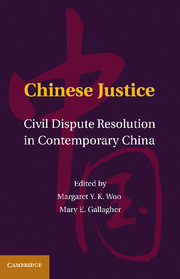Book contents
- Frontmatter
- Contents
- Tables and Figures
- Contributors
- Acknowledgments
- Abbreviations
- Glossary
- Introduction
- PART I LEGAL DEVELOPMENT AND INSTITUTIONAL TENSIONS
- 1 From Mediatory to Adjudicatory Justice: The Limits of Civil Justice Reform in China
- 2 Judicial Disciplinary Systems for Incorrectly Decided Cases: The Imperial Chinese Heritage Lives On
- 3 Legalizing the Local State: Administrative “Legality” at China's Grassroots
- 4 Economic Development and the Development of the Legal Profession in China
- PART II PU FA AND THE DISSEMINATION OF LAW IN THE CHINESE CONTEXT
- PART III LAW FROM THE BOTTOM UP
- Conclusion: Chinese Justice from the Bottom Up
- Index
- References
3 - Legalizing the Local State: Administrative “Legality” at China's Grassroots
Published online by Cambridge University Press: 05 July 2011
- Frontmatter
- Contents
- Tables and Figures
- Contributors
- Acknowledgments
- Abbreviations
- Glossary
- Introduction
- PART I LEGAL DEVELOPMENT AND INSTITUTIONAL TENSIONS
- 1 From Mediatory to Adjudicatory Justice: The Limits of Civil Justice Reform in China
- 2 Judicial Disciplinary Systems for Incorrectly Decided Cases: The Imperial Chinese Heritage Lives On
- 3 Legalizing the Local State: Administrative “Legality” at China's Grassroots
- 4 Economic Development and the Development of the Legal Profession in China
- PART II PU FA AND THE DISSEMINATION OF LAW IN THE CHINESE CONTEXT
- PART III LAW FROM THE BOTTOM UP
- Conclusion: Chinese Justice from the Bottom Up
- Index
- References
Summary
Assessing the development of law in China is a challenging proposition by any standard. One provincial government official I interviewed described current conditions with uncommon eloquence:
Legal reform in the context of China's economic reform is an “overlay” (fugaimiande). The challenge we face is that the overlay contains many bare patches (haiyou kongbai dian). Legal development continues to expand the size and quality of that overlay. But so long as economic development moves faster than legal development, those bare patches only increase in size, number, or both. Economic development moves at the speed of money; legal development moves at the speed of changing minds.
He continued:
The old system was one of administration according to policy, documents, and leaders (yi zhengce xingzheng; yi wenjian xingzheng; yi lingdao xingzheng). In the new system people are supposed to think in terms of administration according to law (yi fa xingzheng). That is what we strive for. But peasants have changed their minds more quickly than officials have changed their ways. Both are changing, but the pace is different.
To be sure, legal development does involve changing minds, and it does demand adjustment and adaptation both by officials and by citizens. Adaptation and adjustment are pressing concerns. But they are not the only, or necessarily even the most important reasons why legal development has not proceeded in the same way or at the same pace across China, up and down the Chinese administrative hierarchy or across the state-society divide.
- Type
- Chapter
- Information
- Chinese JusticeCivil Dispute Resolution in Contemporary China, pp. 91 - 113Publisher: Cambridge University PressPrint publication year: 2011

